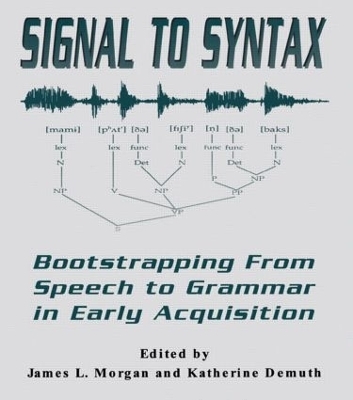
Signal to Syntax
Psychology Press (Verlag)
978-0-8058-1266-4 (ISBN)
In the beginning, before there are words, or syntax, or discourse, there is speech. Speech is an infant's gateway to language. Without exposure to speech, no language--or at most only a feeble facsimile of language--develops, regardless of how rich a child's biological endowment for language learning may be. But little is given directly in speech--not words, for example, as anyone who has ever listened to fluent conversation in an unfamiliar language can attest. Rather, words and phrases, or rudimentary categories--or whatever other information is required for syntactic and semantic analyses to begin operating--must be pulled from speech through an infant's developing perceptual capacities. By the end of the first year, an infant can segment at least some words from fluent speech. Beyond this, how impoverished or rich an infant's representations of input may be remains largely unknown. Clearly, in the debate over determinants of early language acquisition, the input speech stream has too often been offhandedly dismissed as a potential source of information.
This volume brings together internationally-known scholars from a range of disciplines--linguistics, psychology, cognitive and computer science, and acoustics --who share common interests in how speech, in its phonological, prosodic, distributional, and statistical properties, may encode information useful for early language learning, and how such information may be deciphered by very young children. These scholars offer a spectrum of viewpoints on the possibility that aspects of speech may provide bootstraps for language learning; contribute important, state-of-the-art findings across a variety of relevant domains; and illuminate critical directions for future inquiry. The publication of this volume represents a significant step in renewing the bonds between two fields that have long been sundered--speech perception and language acquisition.
James L. Morgan, Katherine Demuth
Contents: Preface. J.L. Morgan, K. Demuth, Signal to Syntax: An Overview. Part I: The Nature, Perception, and Representation of Input Speech.P.D. Eimas, The Perception and Representation of Speech by Infants. B.E. Dresher, Introduction to Metrical and Prosodic Phonology. P. Lieberman, Some Biological Constraints on the Analysis of Prosody. P. Price, M. Ostendorf, Combining Linguistic With Statistical Methods in Modeling Prosody. Part II: Speech and the Acquisition of Words.A. Cutler, Prosody and the Word Boundary Problem. J. Mehler, E. Dupoux, T. Nazzi, G. Dahaene-Lambertz, Coping With Linguistic Diversity: The Infant's Viewpoint. R.N. Aslin, J.Z. Woodward, N.P. LaMendola, T.G. Bever, Models of Word Segmentation in Fluent Maternal Speech to Infants. N.B. Ratner, From "Signal to Syntax": But What Is the Nature of the Signal? C.H. Echols, A Role for Stress in Early Speech Segmentation. K. Demuth, The Prosodic Structure of Early Words. Part III: Speech and the Acquisition of Grammatical Morphology & Form Classes.E. Selkirk, The Prosodic Structure of Function Words. A.M. Peters, S. Strömqvist, The Role of Prosody in the Acquisition of Grammatical Morphemes. L.B. Leonard, J.A. Eyer, Deficits of Grammatical Morphology in Children with Specific Language Impairment and Their Implications for Notions of Bootstrapping. M. Kelly, The Role of Phonology in Grammatical Category Assignments. J.L. Morgan, R. Shi, P. Allopena, Perceptual Bases of Rudimentary Grammatical Categories: Toward a Broader Conceptualization of Bootstrapping. Part IV: Speech and the Acquisition of Phrase Structure.J.J. Venditti, S-A. Jun, M.E. Beckman, Prosodic Cues to Syntactic and Other Linguistic Structures in Japanese, Korean, and English. R. Mazuka, Can a Grammatical Parameter Be Set Before the First Word? Prosodic Contributions to Early Setting of a Grammatical Parameter. M. Steedman, Phrasal Intonation and the Acquisition of Syntax. C. Fisher, H. Tokura, Prosody in Speech to Infants: Direct and Indirect Acoustic Cues to Syntactic Structure. A. Fernald, G. McRoberts, Prosodic Bootstrapping: A Critical Analysis of the Argument and the Evidence. P. Jusczyk, D.G.K. Nelson, Syntactic Units, Prosody, and Psychological Reality During Infancy. Part V: Speech and the Acquisition of Language.L. Gerken, Phonological and Distributional Information in Sytnax Acquisition. J.F. Werker, V.L. Lloyd, J.E. Pegg, L. Polka, Putting the Baby in the Bootstraps: Toward a More Complete Understanding of the Role of the Input in Infant Speech Processing. K. Hirsh-Pasek, M. Tucker, R.M. Golinkoff, Dynamical Systems Theory: Reinterpreting "Prosodic Bootstrapping" and Its Role in Language Acquisition.
| Erscheint lt. Verlag | 13.12.1995 |
|---|---|
| Verlagsort | Philadelphia |
| Sprache | englisch |
| Maße | 152 x 229 mm |
| Gewicht | 680 g |
| Themenwelt | Geisteswissenschaften ► Sprach- / Literaturwissenschaft ► Sprachwissenschaft |
| ISBN-10 | 0-8058-1266-0 / 0805812660 |
| ISBN-13 | 978-0-8058-1266-4 / 9780805812664 |
| Zustand | Neuware |
| Haben Sie eine Frage zum Produkt? |
aus dem Bereich


